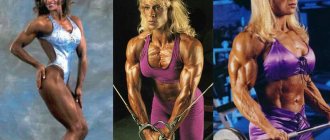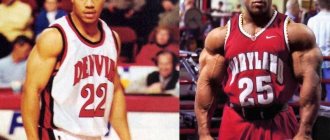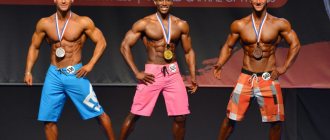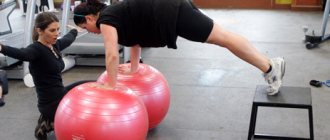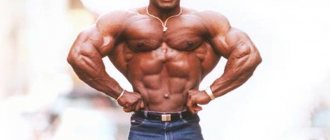The Ms. Olympia tournament dates back to 1980 and is a women's bodybuilding competition created by Joe Weider and held every year by the IFBB.
For twenty years, Ms. Olympia was held as an independent tournament, and since 2000, the International Federation of Professional Bodybuilding decided to combine the two tournaments Mr. and Ms. Olympia into one, as part of the sports show - Olympia Weekend.
Ms. Olympia has undergone several dramatic changes throughout its history. Until 2000, women competed in a single universal weight category, which was subsequently divided into two: light - up to 61 kg (up to 135 pounds) and heavier - over 61 kg. But since 2004, the IFBB nevertheless returned to a single weight category, which still exists today.
Miss Olympia 1980
The honor of holding the title of the first Miss Olympia went to athlete from Texas Rachel McLish. Rachel McLish was born on June 21, 1955, and at the time of participation in the tournament she was exactly 25 years old. Rachel's opponent was a girl from Michigan, Auby Paulick, who won her first professional tournament shortly before Ms. Olympia.
It is worth noting that Rachel McLish, after her victory, was honored to be featured in the film “Pump Iron 2: The Women.”
For her outstanding services to bodybuilding, Rachel McLish was inducted into the IFBB Hall of Fame in 1999.
Miss Olympia 1981
In 1982, Rachel McLish failed to defend the title of Miss Olympia and she lost it to athlete Kike Elomaa, born on July 25, 1955 in Finland, the city of Lokalahti. Kike Elomaa would compete two more times at Ms. Olympia in 1982 and 83, where she would take 3rd and 5th place, respectively.
Today, Kike Elomaa is a current member of the Finnish Parliament.
Recommendations
- Thorne, Gerard; Embleton, Phil (1997). Musclemag International Bodybuilding Encyclopedia by Robert Kennedy: The Best A to Z Book on Building Muscle!
. Musclemag International. pp. 22-23. ISBN 9781552100011 .CS1 maint: multiple names: list of authors (link) - Campos, Thiago (2019). “ANTHROPOMETRIC, DERMATOGLYPHIC AND SOMATOTYPIC INTERVENTION AT ONE OF THE CHAMPIONSHIPMENTS OF THE FEDERATION PARAIBAN OF FISCULTURE, MUSCULATION AND FITNESS” (PDF). Coleção Pesquisa em Educação Física
.
18
(01): 75–84.
ISSN 1981-4313.[ failed
] - ^ a b
Who qualified for the 2015 Olympia? - "The Death of Women's Bodybuilding." T Nation. 2015-08-18. Retrieved 2020-04-03.
- "BREAK: Ms. Olympia competition will return in 2022." FitnessVolt. Retrieved 2020-04-03.
- Announcing the return of Ms. Olympia in 2022
Miss Olympia 1983
The '83 Olympia gave history a new tournament winner, Carla Dunlap, originally from Newwark, New Jersey. Carla Dunlap's professional debut took place in 1979 at the Best In The World tournament, where the girl took 5th place.
It is worth noting that Carla Dunlap's track record is impressive; her sports career ended only in 1993 at the Miss International tournament. Having taken 13th place there, Carla Dunlap decided to end her career.
Throughout her competitive career, Carla Dunlap has climbed to the Miss Olympia stage six times, but only won once.
Miss Olympia 1984-1989
The 1984 Olympia will be remembered by all bodybuilding and fitness fans for the rest of their lives. It was from this Olympia that the unsurpassed Cory Everson, winner of the six-time title of Miss Olympia, began her victorious march. Many experts repeatedly compare the achievements of Cory Everson with her famous colleague Arnold Schwarzenegger.
Cory Everson rose to fame so quickly that until 1989 she had no equal. You can find photos of Cory Everson in our photo archive and see the fitness and bodybuilding star with your own eyes.
For her outstanding achievements in the development of bodybuilding and fitness, Cory Everson was honored to be inducted into the IFBB Hall of Fame in 1999, into the Muscle Beach Venice Body Building Hall of Fame on September 5, 2005, and in 2008. into the National Fitness Hall of Fame.
About protocols[edit | edit code]
After the first preliminary judging, if one looked at the scores, one could find that the four people who had the strongest contracts were placed in first place. As a matter of fact, what was surprising was not even this, but how tightly the top six were “grouped” towards first place, and the remaining athletes in the top ten - towards tenth (Oksana after the first round took 8th-9th place). But Oksana's free program was highly rated - third place - and she managed to get into the top six.
In my subjective opinion, the strongest free program at Ms. Fitness Olympia, judging from the point of view of American spectators, was that of a girl from Canada, Miriam Capes, a former high-level artistic gymnast; she ended up finishing in fourth place. I think that her “freedom” was simply unattainable in terms of acrobatics - a lot of jumps, and all of them were performed cleanly. But, oddly enough, due to arbitrariness, Miriam was only placed fourth. If we talk about the free program as a whole - choreography, costume, plot, presentation - then Oksana is beyond competition.
Miss Olympia 1990-1995
The 1990 tournament was marked by several important events. Firstly, the star and winner of six Miss Olympia titles, Corrie Everson, has left the starry firmament. Secondly, the dark-skinned beauty Lenda Murray, who was also destined to become an eight-time title winner, ascended the tournament platform.
The girl was born in Detroit, Michigan in 1962. The owner of a dozen eminent titles, Lenda Murray held first place until 1995, not allowing anyone to come close to first place. She ended her career in 2004 at the Miss Olympia tournament, where she took third place in the heavyweight category.
It is also worth noting that Lenda Murray climbed onto the Miss Olympia stage 11 times in a row, year after year!!!
In 1990, a turning point came in the rules of the tournament. Lenda Murray's latest victories have shown that women are ceasing to be feminine for the sake of large and colossal muscle volumes. It was decided to divide all the contestants into two categories: light and heavy. Such changes were supposed to bring aesthetics back into sports.
Women's bodybuilding - then and now
The first competition took place in 1980, and already in 1990 the organizers decided to adjust some of the rules. So, after Linda Murray’s victory, experts were concerned that the contestants were building up large muscle volumes to the detriment of their beauty.
Therefore, it was decided to divide the participants into two weight categories - heavy and light. With this, the organizers decided to return the aesthetics of the female body to iron sport. However, in 2004 this decision was canceled.
In 2000, it was decided to somewhat combine the two largest tournaments - Ms. and Mr. Olympia. Now they are held as part of an entire show called Olympia Weekend.
Now girls can compete among themselves in three categories - bodybuilding, fitness and fitness bikini.
Judging female bodybuilding competitors is based on the quality of their muscles and posing - just like men - but also looks at the overall figure. It should not be massive, that is, too reminiscent of a man’s.
The fitness category requires not only harmonious body proportions, but also choreography and acrobatics skills. Here the contestants' entrance is divided into three stages - entry in a bikini, performance of a free program and the final exit.
The fitness bikini category differs from the previous one in that no acrobatic or choreographic skills are required. Also here girls are divided into several categories, depending on their height.
It is videos from the last two categories that most often end up in the top requests at the end of the competition.
Last 2016, the title of winner in the fitness bikini category was given to Courtney King, who is one of the youngest participants - she has been competing since she was 17 years old.
Miss Olympia 1996-1999
Following Lenda Murray's six-year run, a new bodybuilding icon, Kim Chizevsky-Nicholls, hailing from Charleston, Illinois, has arrived on the scene.
Before Ms. Olympia, Kim Chizevsky had already had a series of brilliant victories at famous tournaments such as Ms. International, North American Championship and NPC Continental USA.
Miss Olympia 2000
Since 2000, the tournament has been slightly modernized by creating two categories of female bodybuilders - heavy and light. It turned out that the tournament was won by two athletes in different categories.
This year's lightweight Ms. Olympia was Andrulla Blanchette, originally from London, England. And the victory in the heavyweight division was won by the famous Valentina Chepiga, our compatriot from Kharkov.
Story
1980–1989
In 1980, the first Ms. Olympia competition (originally known as Ms. Olympia) was held with Rachel McLeish winning and becoming the first Ms. Olympia. Rachel was dethroned by Ritva Elomaa in 1981, but regained the title in 1982. George Snyder lost the rights to Ms. Olympia in 1982, and after that, contestants were no longer hand-selected, but instead qualified for the Ms. Olympia title through placings in smaller competitions. As women's bodybuilding grew and progressed, the level of training of the athletes gradually increased, with most competitors in the early shows having very little strength training experience, and the sport gradually evolved towards a more muscular physique. This trend began to emerge in 1983, when McLeish was not participating in major shows. Carla Dunlap won the 1983 Ms. Olympia. Dunlap had a much more muscular physique than previous Ms. Olympia winners McLeish or Elomaa.
In 1984, Corinna Everson won the Ms. Olympia title. Everson won six consecutive Ms. Olympia titles before retiring in 1989 undefeated as a professional, the only woman to ever achieve this.
1990–1999
Competitors typically qualify for Ms. Olympia by achieving certain placings in less professional competitions. However, the cancellation of the Women's Pro World competition in 1990 left only Ms. International as a qualifier for Ms. Olympia. Consequently, the IFBB decided to open the 1990 Ms. Olympia to all women with pro cards, and it included thirty competitors. This was also the first Ms. Olympia without a reigning Ms. Olympia champion defending her title. Lenda Murray achieved a decisive victory by winning the first Ms. Olympia competition she attended in 1990, becoming Corinna Everson's successor. The 1991 Ms. Olympia was the first to be broadcast live. Lenda Murray narrowly escaped Bev Francis, a former Australian powerlifter, by one point that year. Lenda Murray faced a strong challenge from Denise Rutkowski in 1993, and some argue that Rutkowski should have won that year, not Murray. Rutkowski shocked the Ms. Olympia community and fans by retiring in 1994, just as her career was gaining popularity and her potential to win the Ms. Olympia title was high.
In the 1996 Ms. Olympia match, six-time Ms. Olympia champion Lenda Murray was dethroned. Kim Chizewski-Nicholls (then known as Kim Chizewski). Chizewski-Nicholls was previously ranked No. 2 in the 1995 Ms. Olympia, but her victory came as something of a surprise as Murray was widely considered virtually unbeatable. After losing to Chizewski-Nicholls and finishing second again at the 1997 Ms. Olympia, Murray retired from bodybuilding. Chizewski-Nicholls won the Ms. Olympia tournament in 1998. Prague, Czech Republic, the first and only time the competition was held outside the United States.
1992 Miss Olympia changes
In response to the size increases demonstrated by Murray and Francis at the previous Ms. Olympia event, the IFBB attempted to "feminize" the sport. The IFBB, led by Ben Weider, created a series of rules for "femininity" - one line in the judging rules stated that competitors should not be "too big." The judging guide for the contestants stated that they were looking for a feminine but not emaciated physique. Advertising in Muscle and Fitness In 1992, the Ms. Olympia crowned Germany's Anja Schreiner, relegating two-time defending champion Murray to a small "competition" spot. However, Murray apparently lived up to the requirements of "femininity" and managed to retain her title; Schreiner finished 6th and immediately retired from the competition. After 1992, the judging rules were rewritten and the new rules retained the aesthetics provisions but allowed competitions to be judged as physique competitions. Murray won six consecutive Ms. Olympia titles from 1990 to 1995, matching Corinna Everson's record. Produced by: American Sports Network and national television on ESPN. Director: Keith Hobelman
1999 Ms. Olympia: controversy and retirement
The 1999 Ms. Olympia was originally scheduled to take place on October 9th in Santa Monica, California. However, a month before the scheduled date, the IFBB announced the cancellation of the competition. The main reason was the departure of the promoter. Jarka Kastnerova (who promoted the 1998 competition in Prague) for financial reasons, including a small number of advance ticket sales for the 1999 event. The backlash following the announcement led to a flurry of activity, with the competition being moved as part of an all-female extravaganza (promoted by Kenny Cassel and Bob Bonham) to Secaucus, New Jersey on October 2. Last-minute sponsorship came from several sources, most notably $50,000 from Flex magazine. In the chaos, Kim Chizewski-Nicholls won her fourth Ms. Olympia title in a row. Also notable about the 1999 Ms. Olympia was that it was the first Ms. Olympia Iris Kyle competed in. However, after the 1999 Ms. Olympia, Kim Chizewski-Nicholls retired from bodybuilding and began competing in fitness and figure competitions in 2001.
2000–2005
In 2001, Ms. Olympia received a "surprise" victory from Juliette Bergmann, who returned to competition after not competing since 1989. Competing at the Olympia as a lightweight, she defeated heavyweight winner Iris Kyle for the overall title. In the five years that Ms. Olympia competed in multiple weight classes, this was the only time the lightweight winner captured the overall title.
After a five-year absence, six-time Olympia winner Lenda Murray returned to the 2002 Ms. Olympia, where Bergmann won lightweight and Murray won heavyweight and overall. Murray won both the heavyweight and overall divisions at the 2002 and 2003 Ms. Olympia. Murray was dethroned for the second time in her career by Iris Kyle in the 2004 Ms. Olympia title, winning the heavyweight and overall division titles. After losing Ms. Olympia in 2004, Murray retired from bodybuilding.
2000 Miss Olympia changes
The IFBB made several changes to Ms. Olympia in 2000. The first change was that the Ms. Olympia competition was no longer held as a separate competition, but became part of the "Olympic Weekend" in Las Vegas and is held the day before the men's show. The second change involves the addition of heavy and light classes. The third change was the new rules for judging presentations. A letter to participants from Jim Manion (chairman of the professional judges committee) stated that women would be judged on healthy appearance, face, makeup and skin tone. The criteria given in Manion's letter included the statement "symmetry, presentation, separation and muscularity, BUT NOT EXTREMELY!" The 2000 Ms. Olympia is the only Ms. Olympia without an overall winner: Andrulla Blanchette won the lightweight division and Valentina Chepiga won the heavyweight division.
2005 Miss Olympia is changing
The IFBB has introduced what it calls the “20 percent rule,” requiring “female bodybuilding, fitness and figure athletes to reduce their muscle mass by 20%.” The memo said the request "applies to those athletes whose physique requires reduction." Another change added to the 2005 Ms. Olympia was the elimination of the weight class system adopted in 2000. In 2005, Ms. Olympia, Iris Kyle, was dethroned. Yaxeni Oriquen-Garcia.
2006–2014
Iris Kyle regained the Ms. Olympia title in 2006 and went on to win the next eight titles until 2014. With ten total wins, Kyle has won more Olympia titles, male or female, than any other bodybuilder and announced her right to retire. after winning the title in 2014, when the Ms. Olympia finals were held.[3]
2019–present
After five years out of production, on September 14, 2022, host Bob Cicherillo announced at the 2022 Joe Weider Olympic Weekend that Ms. Olympia would return to the 2022 Joe Weider Olympia Weekend.[6]
Miss Olympia 2004
In the lightweight category, the victory was won by an athlete originally from Haiti, but who moved to Canada - Dayana Cadeau. By the way, Diana Kadu has the same nickname as the champion Phill Heath - gifted. The girl participated in IFBB competitions until 2011, and took 16th place at the last Olympia. Dayana Cadeau has appeared on the Olympia platform more than 12 times!!!
In the heavyweight division, Ukrainian Valentina Chepiga took the prize money, which we are extremely happy about.
external reference
- Ms. Olympia Main Website
| |
|
| |
|
Miss Olympia 2005
Following established traditions, the tournament was held in Las Vegas, Nevada. After several years of double victories, the organizers of the competition decided to return to a single category, which was won by Yaxeni Oriquen-Garcia from Venezuela. The girl has incredible experience of competitions and a fantastic 17 appearances on the Olympia podium!!! Yaxeni Oriquen took first place only once, but many times she came to 2-3 places.
Personal life
Recently, it became known about Lauralee's affair with the notorious Mr. Olympia 2018 Shawn Rhoden. Let us remind you that the athlete was suspended from participation in the Mr. Olympia 2019 competition and all subsequent ones due to charges of rape. The alleged crime took place a month after Rodin was awarded the Mr. Olympia title. According to a married female bodybuilder, whose name has not been disclosed, she came to the athlete’s room, considering him solely as her mentor. But the athlete began to pester her. As a result, the girl still managed to leave the room. The police collected samples from her body containing the athlete's DNA.
This incident was followed by a statement from the head of American Media, LLC, David Pecker, announcing that Shawn Rhoden would not take part in the upcoming Mr. Olympia tournament, as well as in all subsequent ones.
On social media, Lauralee and Sean constantly exchange pleasantries.
“I am grateful to God that I have a person like Sean next to me,” Lauralee writes on Instagram. And Rodin does not remain in debt.
Miss Olympia 2006-2014
We have repeatedly witnessed the birth of a legend, and now 2006 gave us another legend, the standard of female bodybuilding that people still look up to today, and this is 2015. Iris Kyle has been honored to be Miss Olympia more than 9 times.
Iris Kyle made her debut in 1999 at the Ms International IFBB Championship. With a height of 180 cm and a weight of 71-73 (in season), the girl competes in the heavyweight division. But given the fact that there is now only one category, Iris Kyle is considered the absolute champion.
We look forward to the 2015 Ms. Olympia, where it will be clear whether Iris Kyle will once again take the title or whether we will witness the birth of a new legend.
Women's Olympia - where it all began
The competition, of course, did not arise immediately and not out of nowhere. By the time the first competition took place in 1980, women's bodybuilding was gradually becoming more popular.
The first competition, which was designed to determine the best in this sports discipline, was Miss Universe. It took place back in 1965. But only with the advent of the female version of the Olympia in 1980 can we consider that women in bodybuilding were given a 100% green light.
The first competition was organized by George Snyder, who personally selected the contestants. In order to be included, girls had to send their photographs, as well as a resume with information about themselves. The main selection criterion for Snyder was then whether the contestant could be used as a model in his fitness industry.
